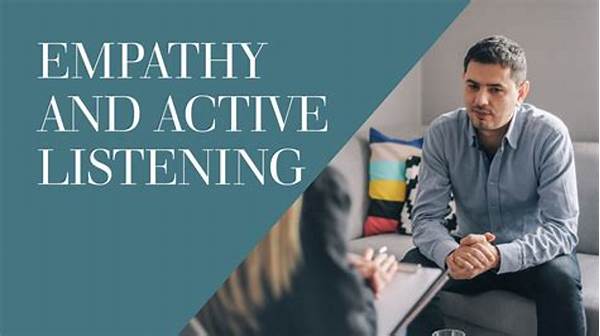In a world buzzing with constant communication, it’s ironic how often true understanding is lost in translation. Many of us are guilty of nodding our heads while thinking of something else, or multitasking during conversations. The art of active listening has been overshadowed by the chaos of information overload. Yet, developing trust through active listening remains the cornerstone of effective communication and relationships. By genuinely listening to others, we not only understand their words but also their emotions, allowing intimacy and trust to flourish.
The Power of Being Present
Active listening demands more than just hearing words—it requires genuine presence. When you actively listen, you are fully engaged, offering your complete attention to the speaker. This attentiveness communicates respect and appreciation, which naturally fosters trust. It invites openness in conversation, allowing people to share thoughts and feelings freely. By developing trust through active listening, you encourage deeper connections. It becomes clear that listening isn’t just about absorbing information; it is about creating a mutual space of understanding where relationships can thrive.
In work settings, developing trust through active listening leads to more cohesive team dynamics. When individuals feel heard, they’re more inclined to pledge their loyalty and cooperation. In personal relationships, it can transform discord into harmony, as partners recognize the value each statement holds. A warm nod, affirming words, or even simple silence when appropriate—these actions convey that you are there, fully present. Trust naturally blossoms in this environment.
Simple Steps to Listen Actively
1. Maintain eye contact to show engagement and respect.
2. Nod and give verbal affirmations to acknowledge understanding and encourage the speaker.
3. Avoid interrupting as it shows a lack of interest in their perspective.
4. Reflect on what you’ve heard by paraphrasing or summarizing.
5. Ask open-ended questions that show genuine curiosity and interest.
These steps, when practiced regularly, strengthen your ability in developing trust through active listening. They create an atmosphere where true dialogue can occur because both parties are valued and heard. Over time, these practices transform interactions from superficial exchanges to meaningful conversations, building long-lasting trust.
Creating Open Dialogue
Developing trust through active listening isn’t a one-way street; it requires a mutual agreement to honor each other’s voices. This approach encourages open dialogue, making communication a collaborative process rather than a performance. When people feel their voices are valued, they’re braver in expressing ideas and confidences. It invites peers and loved ones alike to partake in an enriching exchange of thoughts and emotions, enriching relationships through mutual understanding and respect.
In romantic relationships, active listening can revitalize a stale conversation. Partners who actively listen to each other often solve conflicts more efficiently because they get to the heart of what’s truly being said. It encourages empathy, allowing partners to see the world from each other’s eyes. In professional exchanges, this practice reduces misunderstanding and fosters an inclusive culture where all contributions are acknowledged and appreciated.
Overcoming Listening Barriers
1. Distractions: Create a conducive environment to focus completely.
2. Judgment: Keep an open mind and reserve judgments.
3. Preoccupation: Let go of your mental clutter to remain present.
4. Rehearsal: Avoid formulating responses while the speaker is talking.
5. Emotional barriers: Be aware of your emotional triggers to remain objective.
6. Bias: Set aside personal biases to understand the speaker’s perspective.
7. Information overload: Process information at a comfortable pace.
Developing trust through active listening involves overcoming these barriers. Show the speaker that you honor their message by understanding them fully. As these barriers fade, they create space for authentic communication and foster trusting relationships.
Building Empathy and Understanding
Developing trust through active listening is synonymous with building empathy. It enables us to walk in others’ shoes, see through their eyes, and connect on a human level. This bond is the foundation for deep interpersonal connections. It’s hard to judge harshly when we intentionally listen and understand. Our capacity for compassion increases as we learn to connect beyond the spoken words. Our actions become more thoughtful, and our relationships turn more profound.
In professional environments, active listening can be the key to stronger teamwork. A team flourishes when its members feel acknowledged and understood. Creativity and problem-solving skills are heightened when diverse perspectives are actively considered.
The Practice of Active Listening
Practicing active listening goes beyond personal gain—it’s a service to others, signifying that their words matter. In doing so, we bridge gaps between misunderstanding and understanding. Whether personal or professional, this practice is invaluable in nurturing trust. It transforms how we see the world and how the world sees us.
The beauty of developing trust through active listening lies in its simplicity and profound impact. As we dedicate time to cultivate this skill, we may find our interactions more rewarding, our relationships more authentic, and our connection with the world more profound.
Summary
Developing trust through active listening is a transformative practice that strengthens personal and professional relationships. Active listening is about presence and acknowledgment, creating a foundation of mutual respect where trust can thrive. By applying simple techniques, we encourage open, empathetic dialogue that honors diverse perspectives and nurtures deeper connections.
The journey to becoming an active listener involves overcoming barriers such as distractions and biases, reflecting empathy through understanding, and creating safe spaces for meaningful discourse. As we embrace active listening, our interactions evolve beyond superficial exchanges to authentic, trust-building conversations.
By committing to developing trust through active listening, we open doors to enriching interactions. It allows us to truly understand and be understood, creating pathways to stronger bonds and lasting respect. As we navigate our busy, interconnected world, the skill of active listening serves as our guide to fostering genuine relationships.
